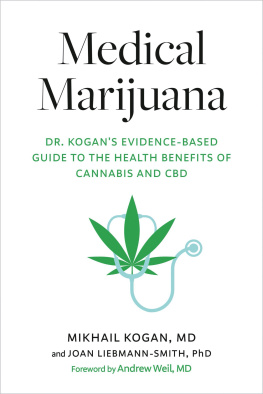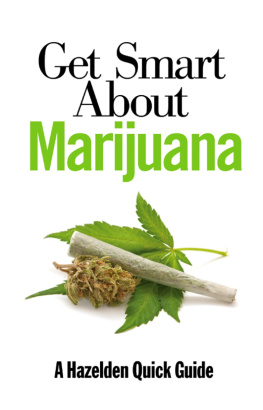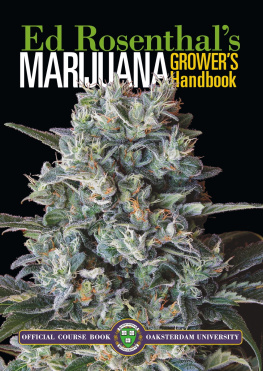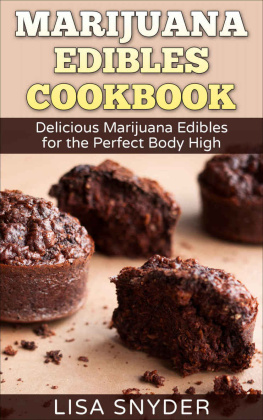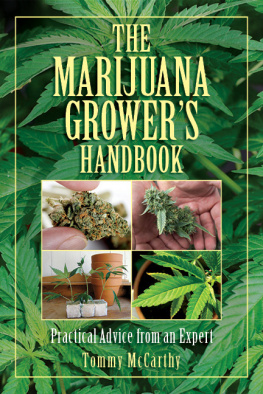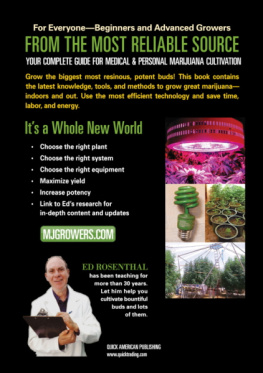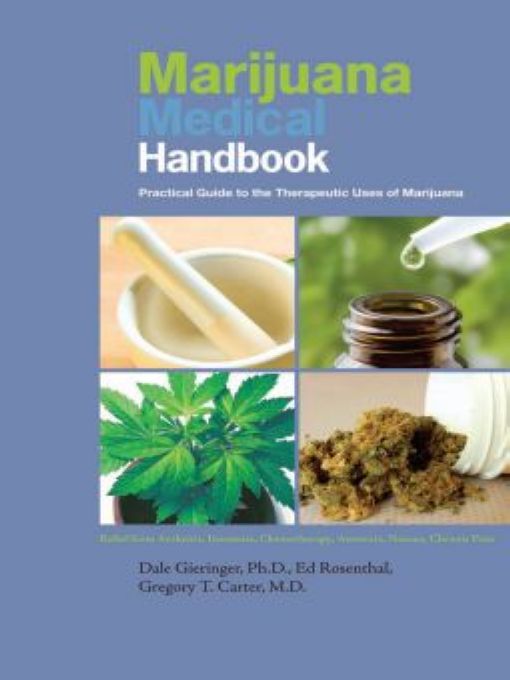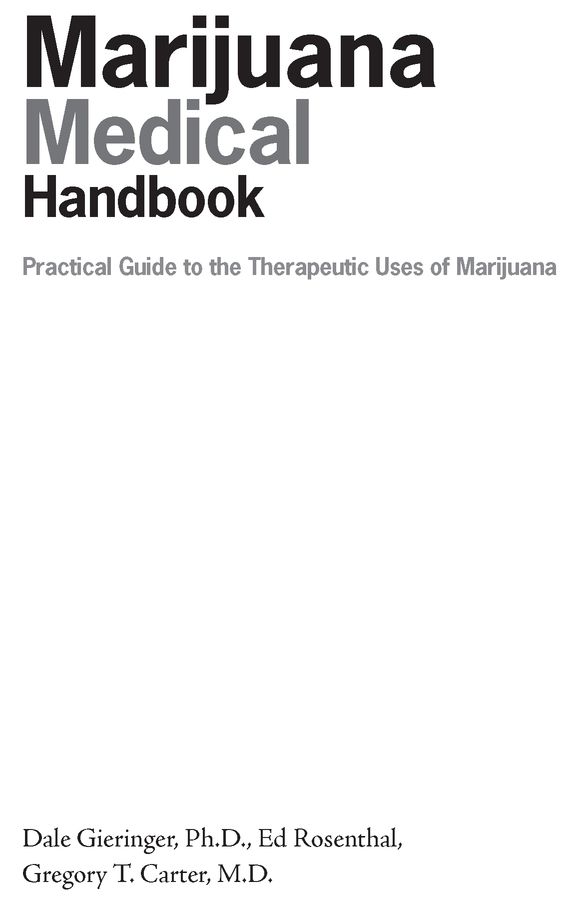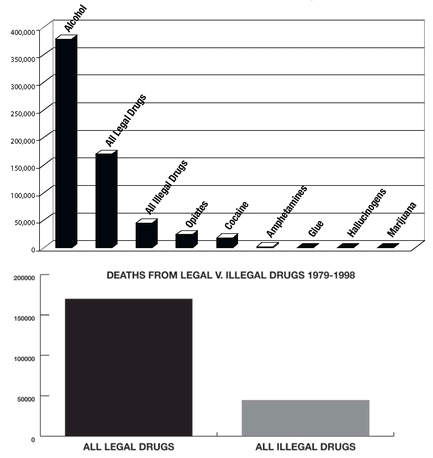Table of Contents
Dedication
Dedicated to Tod Mikuriya, M.D. (1933-2007),
pioneering medical cannabis practitioner and coauthor of
the first edition of Marijuana Medical Handbook, whose
clinical observations and data on over 9000 patients
provided an invaluable basis for this book.
Acknowledgements
We would like to acknowledge Paul Armentano,
Dr. Franjo Grotenhermen, Dr. Ethan Russo,
Dr. Robert Melamede, Dr. Thomas OConnell,
Arno Hazekamp, Valerie Corral, Rick Pfrommer and
Harborside Health Center for their assistance.
ONGOING DEVELOPMENTS: Research on marijuanas medical use advances
constantly. Current developments along with legal and policy changes are
posted at www.norml.org
Forward to the Second Edition
The ten years since the first edition of this book appeared have witnessed exciting advances in medical marijuana. At that time, the voters of California had just approved the first state law legalizing medical marijuana, the Compassionate Use Act of 1996 (Proposition 215). Since then, 11 more states have approved medical marijuana laws, as have Canada, Austria and the Netherlands, and a growing tide of other states and nations are moving toward similar legislation.
Ten years of research have validated many findings that we tentatively outlined in the first edition of this book, at that time based on anecdotal reports. New clinical studies have found that marijuana and its ingredients are effective in treating symptoms of HIV/AIDS, multiple sclerosis, chronic and acute pain, and Tourettes syndrome. Other studies have pointed toward a host of new applications, including gastro-intestinal disorders, rheumatoid arthritis, fibromyalgia, ALS, hepatitis C, perhaps even diabetes, Alzheimers and cancer. New biochemical research has improved our understanding of cannabinoids, illuminating their anti-inflammatory, analgesic, immuno-modulatory, neuro-protective, and anti-tumorogenic properties.
Meanwhile, the practice of cannabis medicine has vastly expanded. Over 300,000 Americans are now using marijuana under state medical marijuana laws. This is actually just the tip of the iceberg, as surveys indicate the potential U.S. patient population could be over three million. Thousands of physicians are now recommending marijuana under state medical marijuana laws. Despite the federal governments efforts to suppress them, hundreds of cannabis dispensaries and patients coops have sprung up to supply medicine to patients in California and elsewhere.
The past decade has also seen important advances in the development of new methods for administering cannabis. Vaporizers that effectively eliminate the toxins from marijuana smoke have been developed. In the UK, GW Pharmaceuticals has developed a pharmaceutical spray made from natural cannabis extract that is now legally approved in Canada and also available to certain patients in 22 other countries.
Unfortunately, one thing has not changed, and that is the U.S. governments obstinate opposition to medical marijuana. Despite the overwhelming evidence of its medical efficacy, marijuana remains firmly classified as an illegal, Schedule I drug - that is, one with no (government-acknowledged) medical value. In 1999, the National Institute of Medicine issued a report on medical marijuana finding that it had unique benefits and urging further research, but its conclusions were ignored. The Supreme Court has twice rejected legal challenges to the federal laws against medical marijuana. The U.S. Justice Department and Drug Enforcement Administration (DEA) have launched scores of raids, arrests, and prosecutions against medical marijuana providers and growers in California and elsewhere. The DEA has even gone so far as to obstruct research into medical marijuana, blocking approval of new production facilities that would allow marijuana to be developed as an FDA-approved drug. As a result, marijuana remains no closer to FDA approval today than it was ten years ago.
It would be foolhardy to predict when the federal government will come to its senses and legalize medical marijuana, though logic would dictate that it should be legalized soon. In the meantime, there is no valid reason for Americans or anyone else to be denied the benefits of this valuable medicine. Ten years from now, countless more will be using medical marijuana than today.
This book is written for the sake of those interested in better understanding and exploring this natural, home-grown medicine.
Chapter 1
How Safe is Marijuana?
Marijuana is a remarkably safe drug. Although its primary active ingredients (THC and other cannabinoids) produce psychoactive effects at doses of a couple of milligrams, they do not have lethal effects. Unlike other psychoactive drugs, including alcohol, aspirin, opiates, nicotine, and caffeine, cannabis is not known to cause fatal overdoses. The DEAs [Drug Enforcement Administration] own administrative judge Francis Young, in his 1988 decision recommending legalization of medical marijuana, wrote, Marijuana, in its natural form, is one of the safest therapeutically active substances known to mankind. From animal experiments, it has been estimated that a lethal dose of cannabis would be 20,000 to 40,000 times a normal dose: approximately 40 to 80 pounds of marijuana! No deaths from cannabis overdose have ever been recorded.
Marijuanas safety may be explained by how it acts in the body. In recent years, scientists have discovered that marijuanas active ingredients, the cannabinoids, work on a signaling system in our bodies known as the endogenous cannabinoid, or endocannabinoid system. Receptor cells for this system are concentrated in many parts of the brain and body, but are relatively lacking in the brainstem, which controls vital functions such as breathing and heartbeat. Therefore, even strong doses do not endanger life.
This is not to say that marijuana cannot have adverse effects. Like all drugs, marijuana can cause harm if taken in excess or abused. In addition, certain people simply respond poorly to marijuana,
RECREATIONAL DRUG-RELATED DEATHS, 1979-1998
Source: Centers for Disease Control, cited at http://briancbennett.com/charts/death/rec-intox-deaths.htm
finding it more unpleasant than beneficial. But whats important is that people have access to accurate information about marijuana. Without information, how will they know whether it will benefit them, what dose they should take, and how they can gain access to a regular supply?
History of Marijuana as Medicine
Marijuana, botanically known as cannabis, has been around for thousands of years. It has several species or varieties, most notably cannabis sativa and cannabis indica. Until 1937, marijuana was legal and was commonly prescribed medicinally in the U.S. Despite its prohibition, marijuana continues to be one of the most widely used drugs in America.
The medical and recreational uses of cannabis have been known since ancient times. In China, it appears in the Pen Tsao as a remedy for gout, rheumatism, malaria, beriberi, constipation, and absentmindedness. Tradition ascribes the Pen Tsao to the legendary emperor Shen-Nung, said to be from the 3rd millennium BC, although modern scholarship dates it to the 1st century AD. The famous surgeon Hua To allegedly used cannabis to perform painless operations in the second century A.D. Eastern Indian documents in the Atharveda, dating from before the first millennium BC, also refer to the medicinal use of cannabis.



